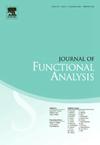Solutions to SU(n + 1) Toda system generated by spherical metrics
IF 1.6
2区 数学
Q1 MATHEMATICS
引用次数: 0
Abstract
Following A.B. Givental (1989) [5], we refer to an n-tuple of Kähler forms on a Riemann surface S as a solution to the SU Toda system if and only if where is the Cartan matrix of type . In particular, when , this solution corresponds to a spherical metric. Using the correspondence between solutions and totally unramified unitary curves, we show that a spherical metric ω generates a family of solutions, including . Moreover, we characterize this family in terms of the monodromy group of the spherical metric. As a consequence, we obtain a new solution class to the SU Toda system with cone singularities on compact Riemann surfaces, complementing the existence results of Lin et al. (2020) [9].
球面度量生成的SU(n + 1)Toda系统的解
根据A.B. Givental(1989)[5],我们在黎曼曲面S上引用Kähler形式的n元组(ω1,…,ωn)作为SU(n+1) Toda系统的解当且仅当(Ric(ω1),…,Ric(ωn))=(2ω1,…,2ωn)Cn,其中Cn是an型的Cartan矩阵。特别地,当n=1时,这个解对应于一个球度规。利用解与完全无分支的酉曲线之间的对应关系,我们证明了一个球面度规ω产生一系列解,包括(i(n+1 - i)ω)i=1n。此外,我们用球度规的单群来描述这个族。因此,我们得到了紧致Riemann曲面上具有锥奇点的SU(n+1) Toda系统的一个新的解类,补充了Lin et al.(2020)[9]的存在性结果。
本文章由计算机程序翻译,如有差异,请以英文原文为准。
求助全文
约1分钟内获得全文
求助全文
来源期刊
CiteScore
3.20
自引率
5.90%
发文量
271
审稿时长
7.5 months
期刊介绍:
The Journal of Functional Analysis presents original research papers in all scientific disciplines in which modern functional analysis plays a basic role. Articles by scientists in a variety of interdisciplinary areas are published.
Research Areas Include:
• Significant applications of functional analysis, including those to other areas of mathematics
• New developments in functional analysis
• Contributions to important problems in and challenges to functional analysis

 求助内容:
求助内容: 应助结果提醒方式:
应助结果提醒方式:


